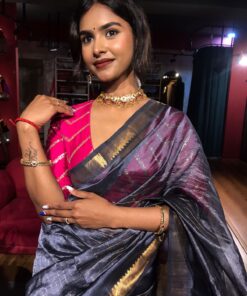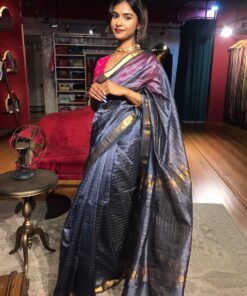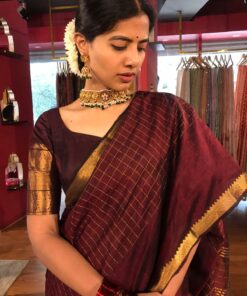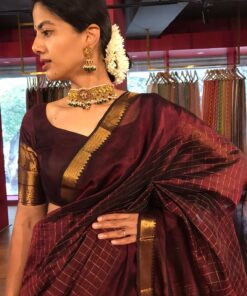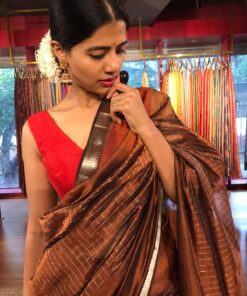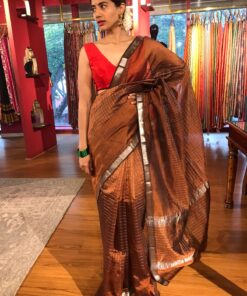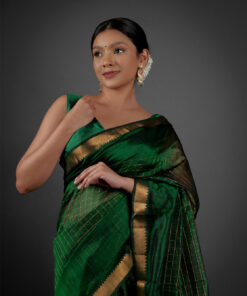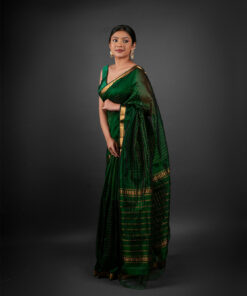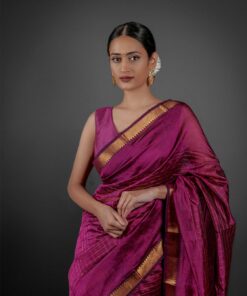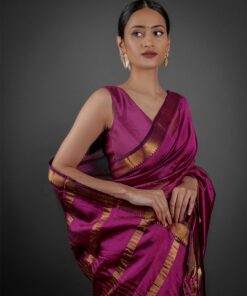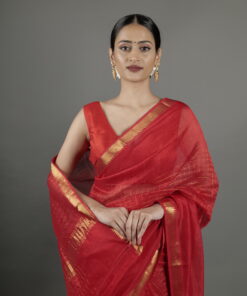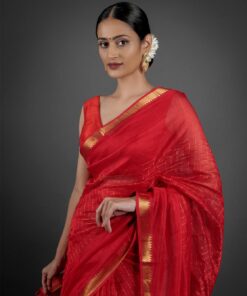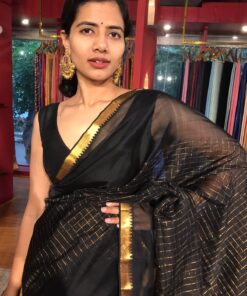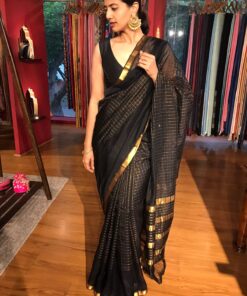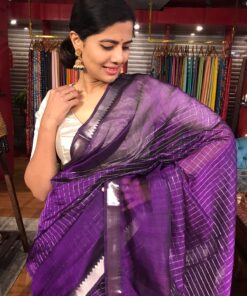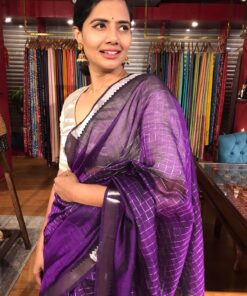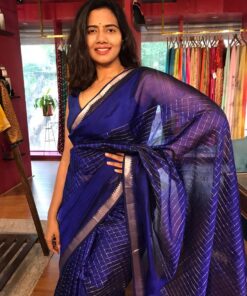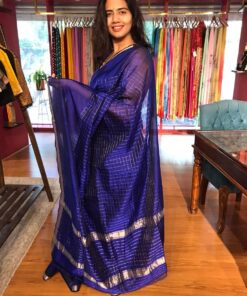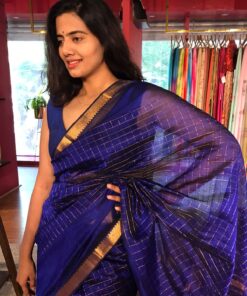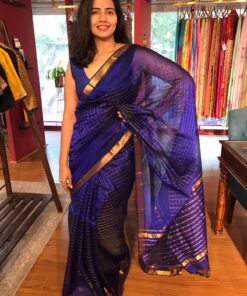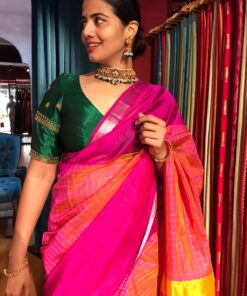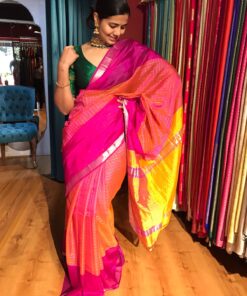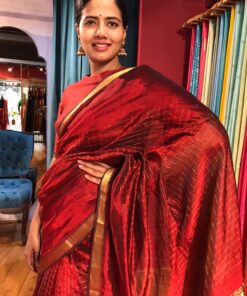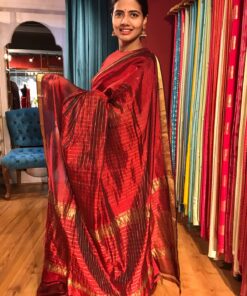- What makes Mangalagiri silk sarees unique compared to other silk sarees?Mangalagiri silk sarees are known for their distinct style and superior craftsmanship. These sarees feature intricate patterns, often with traditional motifs, and are made from lightweight silk, making them comfortable for long wear. At Mirra Clothing, we offer these sarees in a variety of colors and designs, ensuring that each piece is unique making it one of our most bestselling pieces. Our affordable pricing allows you to experience the elegance of these mangalagiri silk sarees without exceeding your budget.
- Where can I buy Mangalagiri silk sarees online at the best price?You can buy Mangalagiri silk sarees online at the best price at Mirra Clothing. We offer a wide range of Mangalagiri silk sarees with unique ccolors and patterns, all at affordable prices. Shopping with us means you don’t have to compromise on quality or style. Additionally, we offer worldwide shipping, so no matter where you are, you can get your hands on our beautiful sarees with ease.
- What can I expect from the Mangalagiri silk sarees collection?The Mangalagiri silk sarees collection at Mirra Clothing offers a blend of tradition and contemporary style. You can expect a wide range of colors and exquisite craftsmanship that highlight the unique Mangalagiri weaving techniques. Whether you are looking for something classic or trendy, we have sarees for every taste and occasion. Plus, our video call service allows you to get a personalized shopping experience, ensuring you pick the perfect saree.
- What is the origin of Mangalgiri silk sarees and why are they so popular?Mangalgiri silk sarees originate from the town of Mangalgiri in Andhra Pradesh, where they are woven using fine silk and cotton threads. These sarees are renowned for their lightweight feel, intricate borders, and vibrant colors, making them a popular choice for both everyday and festive wear. At Mirra Clothing, we offer these authentic sarees that beautifully reflect the cultural heritage of Mangalgiri, all at affordable prices, so you can enjoy traditional elegance at a great value. Plus, we offer multiple payment methods, making your shopping experience even more convenient.
- How can I buy authentic Mangalgiri sarees online?To buy authentic Mangalgiri sarees online, head to Mirra Clothing, where we bring you a curated collection of these beautifully crafted sarees. We ensure authenticity in every piece, from the traditional weaving techniques to the rich silk fabric. With our worldwide shipping, you can easily order your perfect saree from anywhere and have it delivered to your doorstep.
- What are Mangalagiri sarees with zari borders, and how do they enhance the saree’s beauty?Mangalagiri sarees with zari borders feature beautiful metallic threads woven into the fabric, adding an elegant shimmer and enhancing the saree's overall beauty. What you often find is Gold or Silver Zari Weaves. The zari border gives the saree a regal touch, making it perfect for semi-formal or festive occasions. At Mirra Clothing, we offer a stunning collection of these sarees, and with our wide range of readymade blouses, you can easily find the perfect pairing to complete your look.
- What is the difference between Mangalagiri pattu sarees and other types of silk sarees?Mangalagiri pattu sarees are crafted from a fine blend of silk and cotton, making them lighter and more comfortable to wear than traditional heavy silk sarees. The unique weaving technique used in Mangalgiri ensures a smooth, breathable texture, making these sarees perfect for both daily wear and special occasions. At Mirra Clothing, our Mangalagiri pattu sarees are celebrated for their exceptional quality, intricate designs, vast color options and a timeless appeal. With our affordable prices, you can indulge in pattu sarees without compromising on style or budget, making it a smart choice for every wardrobe.
- What makes Mangalagiri sarees with zari borders special compared to other handloom sarees?Mangalagiri sarees with zari borders are known for their fine pit-loom weaving technique, crisp texture, and distinctive temple border designs. These Mangalagiri sarees with zari borders add a timeless elegance and traditional charm to festive and formal occasions.
- Are Mangalagiri silk sarees suitable for festive and formal occasions?Yes, Mangalagiri silk sarees are ideal for festive and formal occasions due to their rich sheen, lightweight texture, and elegant temple borders. You’ll find beautifully handwoven Mangalagiri silk sarees perfect for celebratory gatherings at Mirra Clothing.
- What is a Mangalgiri saree, and how is it traditionally made?A Mangalgiri saree is a handloom saree woven using fine cotton or silk threads on pit looms, featuring signature temple borders and solid or striped body designs. Authentic Mangalgiri sarees showcase centuries-old craftsmanship from the weaving town of Mangalagiri.
- What are the unique features of authentic Mangalagiri sarees?The unique features of authentic Mangalagiri sarees include their lightweight feel, weaving on traditional pit looms, and signature temple borders that stand out without elaborate motifs. Their crisp texture and smooth finish make these sarees a popular choice for both everyday and festive wear.
- Are Mangalagiri silk cotton sarees comfortable for daily and occasional wear?Yes, Mangalagiri silk cotton sarees are exceptionally comfortable for daily and occasional wear. The blend of silk and cotton offers a breathable, soft texture while retaining the graceful drape of traditional Mangalagiri silk cotton sarees.
- What are Mangalagiri pattu sarees, and how do they differ from regular silk sarees?If you’re wondering what are Mangalagiri pattu sarees, they are pure silk sarees made with the traditional Mangalagiri weave. Unlike regular silk sarees, Mangalagiri pattu sarees are known for their minimalistic designs, featuring plain or striped bodies and distinctive temple borders, which make them lightweight and effortlessly elegant.
- How can I identify original Mangalagiri silk sarees when shopping online?To identify original Mangalagiri silk sarees when shopping online, check for product details mentioning pit-loom weaving, temple borders, and the characteristic crisp finish. Authentic Mangalagiri silk sarees are known for their solid hues and minimalistic patterns without elaborate woven motifs.
- What factors affect Mangalagiri saree price, and how can I get the best value?Several factors affect Mangalagiri saree price, including the purity of silk, quality of zari, weaving intricacy, and whether the saree is handwoven or machine-made. To get the best value, shop genuine Mangalagiri sarees online from trusted stores like Mirra Clothing, where you’re assured of authentic quality and fair pricing.
- Where can I buy genuine Mangalagiri sarees online with verified quality?You can buy genuine Mangalagiri sarees online at verified, reputable platforms like Mirra Clothing. Their curated range of Mangalagiri sarees ensures quality craftsmanship, authentic weaves, and reliable customer service.
Explore Our Exquisite Mangalgiri Silk Sarees Collection: Tradition Meets Elegance
At Mirra Clothing, our Mangalgiri silk sarees are a celebration of tradition and elegance, blending the rich heritage of handloom craftsmanship with modern sensibilities. Handwoven to perfection, each saree in our collection offers unparalleled comfort, beauty, and affordability, making it the perfect choice for any festive or celebratory occasion. Buy Mangalagiri Silk Sarees Online at Best Price only at Mirra Clothing, We offer a wide range of colors in both Mangalagiri Silk and Mangalagiri Cotton Sarees
Why Choose Mirra Clothing’s Mangalgiri Silk Sarees?
Lightweight and Luxurious: Our Mangalagiri Silk Sarees Collection are known for being extremely lightweight, making them easy to drape and carry throughout the day. Despite their comfort, these sarees exude the grandeur of traditional Kanjeevaram sarees, giving you that luxurious look at a fraction of the weight and cost.
Authenticity Guaranteed: We take pride in offering only the most authentic Mangalgiri silk sarees, made from pure silk. Unlike many mixed fabrics found in the market, our sarees promise true craftsmanship and heritage. When you choose Mirra Clothing, you’re investing in quality that stands out.
For All Generations: Whether you’re in your 20s or your 50s, our Mangalgiri sarees cater to a broad range of ages. These Mangalagiri Silk sarees have a timeless appeal, blending youthful vibrancy with classic sophistication, making them the perfect choice for everyone.
Celebrate Every Occasion in Style
From festivals like Diwali to grand occasions such as anniversaries, our Mangalgiri sarees are your go-to attire for making a statement. The unique texture, sheen, and patterns of these sarees add a touch of elegance that’s ideal for moments of celebration.
A Palette of Colors to Suit Your Every Mood
We offer an extensive range of colors, each carefully selected to enhance the traditional appeal of the Mangalgiri saree. Elevate your ethnic wardrobe with our stunning Mangalagiri Sarees with Zari Borders in trending colors for every celebration.
Our Mangalagiri Silk Sarees Collection includes:
- Deep Reds and Maroons: For those who love bold, regal colors, our rich red and maroon Mangalgiri sarees exude opulence, perfect for weddings or festive events.
- Royal Blues: Looking for something striking yet classy? Our Royal Blue Mangalgiri sarees offer a stunning blend of tradition and modernity.
- Earthy Greens and Mustards: Perfect for day functions or traditional ceremonies, these earthy tones bring out the best of handwoven beauty.
- Elegant Blacks: A timeless choice for any evening occasion, our black Mangalgiri sarees add sophistication and grace to your wardrobe.
Classic Designs and Patterns
Our sarees are a tribute to the traditional chequered patterns that Mangalgiri sarees are famous for. These Mangalagiri Sarees with Zari Borders and With intricate handwoven details elevate the overall look, making each saree a masterpiece in itself. The blend of classic and modern patterns ensures that our Mangalagiri Silk Sarees are not just an attire but a style statement.
Affordability Without Compromise
One of the key aspects that sets Mirra Clothing apart from the competition is our ability to offer affordable luxury. Our Mangalgiri silk sarees may resemble the expensive Kanjeevaram sarees in appearance, but they come at a much more accessible price. This allows you to enjoy high-quality, traditional craftsmanship without breaking the bank.
Buy Authentic Mangalgiri Sarees Online
Shopping for authentic Mangalgiri silk sarees has never been easier. With international shipping and cash on delivery options available, we make it convenient for you to purchase the saree of your dreams, no matter where you are. Plus, our sarees are customizable to suit your style and preference, ensuring you get a piece that’s truly unique to you.
Why Choose Mirra Clothing?
Affordable Luxury
We understand that ethnic clothing can often come with a hefty price tag. That’s why you can Buy Mangalagiri Silk Sarees Online at Best Price at Mirra Clothing. We focus on offering designer wear that is both unique and affordable. Our partnership with weavers across India allows us to bring you custom-designed sarees—30% of which are exclusive to our brand—making it easier for you to stand out.
Products and Services
At Mirra Clothing, we offer an extensive range of silk sarees, blouses, lehengas online, including:
- Designer Silk Sarees and Blouses
- Banarasi Silks
- Kanchipuram Silks
- Georgettes
- Chiffons
- Ethnic Saree Gowns
- Lehengas, Kurtis, and Designer Blouses
And more
Our collections are perfect for various occasions, from weddings to festive celebrations.
Customization at Your Fingertips
One of the unique aspects of our brand is the ability to customize your saree in terms of color and design. Our in-house store team is dedicated to guiding you through the selection process via video call, ensuring that you find the perfect saree tailored to your needs.
Discover the timeless beauty of our Mangalagiri Pattu Sarees, where intricate handwoven designs meet luxurious silk fabric for a perfect blend of comfort and style.
Solving Common Problems
We recognize the challenges faced by our customers in the ethnic wear market:
- High Costs of Ethnic Clothing
- Difficulty in Finding Tailored Fits for Blouses and Kurtis
- Limited Availability of Affordable Designer Wear
- Inconvenience of In-Store Shopping
- Lack of Variety in One Place
Our solutions focus on:
- Providing unique designer wear that is affordable.
- Offering an easy and convenient online shopping experience with customized blouse stitching and global shipping.
- Bringing a wide range of products under one roof.
Unique Value Proposition
Mirra Clothing stands for trust and quality. We aim to make designer collections accessible and affordable while providing tailored options at the click of a button.
Customer Trust and Testimonials
Join our community of satisfied customers, known as Mirra Queens. Check out their reviews and experiences here.
If you’re interested in exploring sarees similar to Mangalgiri, check out our curated collections below:
Looking to try something more modern, bold, or simply want to explore? Take a look at these unique categories:
Occasion-Specific Sarees from the house of Mirra Clothing
Not sure which one is right for you? You can also shop by occasion with these helpful links. we offer a variety of categories:
- Anniversary Sarees: Perfect for celebrating love.
- Festive Sarees: Ideal for joyous celebrations—Browse Festive Collection.
- Formal Wear Sarees: Sophisticated choices for professional settings—Explore Formal Collection.
- Wedding Sarees: Exquisite options for your special day—View Wedding Collection.
- Party Wear Sarees: Glamorous selections for any party—Shop Party Collection.
Complement Your Look with Blouses
Don’t forget to check out our wide range of blouses, available from plain to intricately embroidered styles. Find the perfect match for your saree here: Blouse Collection.
Explore our collections to elevate your saree wardrobe with elegance and style!
